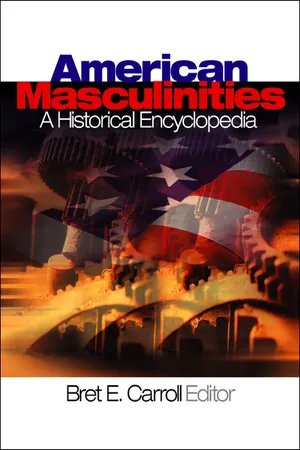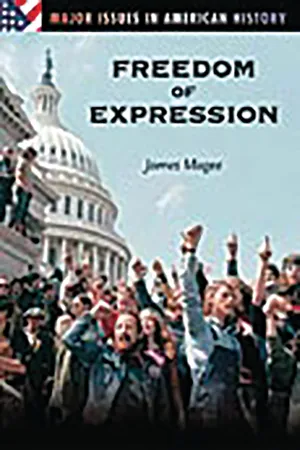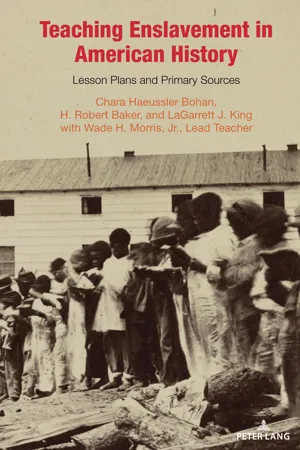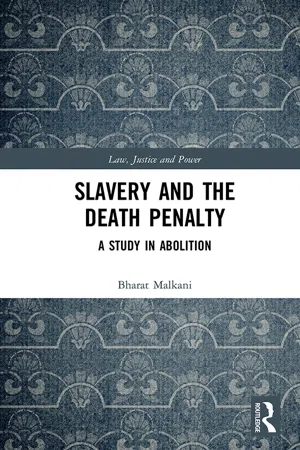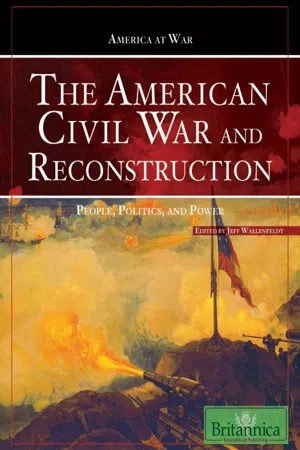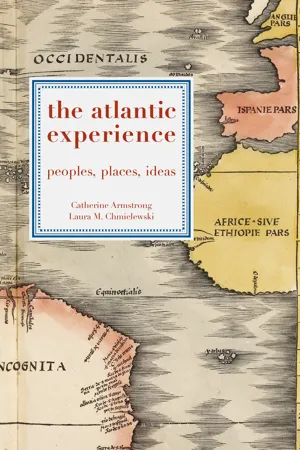History
Abolitionism
Abolitionism was a social and political movement aimed at ending the institution of slavery. It gained momentum in the 18th and 19th centuries, particularly in the United States and Britain. Abolitionists advocated for the immediate emancipation of all enslaved individuals and worked through various means, including petitions, literature, and direct action, to achieve this goal.
Written by Perlego with AI-assistance
Related key terms
1 of 5
9 Key excerpts on "Abolitionism"
- Bret Carroll(Author)
- 2003(Publication Date)
- SAGE Publications, Inc(Publisher)
Abolitionism Although opposition to the institution of slavery in North America dates back into the eighteenth century, the 1831 pub-lication of William Lloyd Garrison’s newspaper, the Liberator , is often cited as the inaugural event of the abolition movement in America. In the decades prior to the Civil War, abolitionists built a social movement and a political campaign aimed at ending slavery in the United States—a goal that was accom-plished with the ratification of the Thirteenth Amendment in 1865. The definitions of manhood used by abolitionists varied in detail, but they generally included economic, political, and spiritual independence. Slavery had to be abolished, at least in part, because it threatened these cherished ideals. Historians are increasingly emphasizing the significant contributions of different African-American communities to the movement, particularly in its early years; nonetheless, the majority of both the abolitionist leadership and the rank-and-file of the movement came from the white, north-ern middle class. Not surprisingly, in many respects aboli-tionist conceptions of manhood resembled those common in the North. Influenced by the ideals of political equality, spiritual empowerment, and economic independence asso-ciated with the American Revolution, the religious revivals of the Second Great Awakening, and the market revolution, antebellum northerners articulated a vision of manhood defined by the liberty and power of the individual male cit-izen. Abolitionists shared the northern middle-class’s con-ception of an ideal society in which a “man” owned his own labor, and thus possessed both the means and the opportu-nity to acquire property, which would, in turn, ensure his political rights and his family’s economic security.- eBook - PDF
- James Magee(Author)
- 2002(Publication Date)
- Greenwood(Publisher)
3 The Abolitionist Movement Various Americans had objected to slavery before the Constitution was written and thereafter until the Civil War and the Thirteenth Amend- ment ended slavery in the United States. Religious groups, such as the Quakers, saw slavery as a sin; others saw it as immoral, especially in a country built on the notion of equality. Followers of the Enlightenment thought that slavery retarded progress because it debased labor. Criti- cism was continuous but relatively mild. By the mid-1830s, however, opponents had become a formidable political voice that refused to be silenced. A new brand of abolitionists burst onto the political scene and equated slavery with sin but now demanded its "immediate" eradica- tion. Their political pressure threatened the slaveholding economy of the South, and the planter class resisted. Abolitionists also irritated north- erners who feared southern boycotts of their manufactured goods and others who dreaded the prospect of millions of freed slaves in search of a better life in the North. Politics was another important factor; the South had electoral votes, and neither Democratic nor Whig Party leaders in the North were inclined to write off the South by siding with the enemies of slavery. Abolitionists were inspired by the intellectual and social theories of their time: idealism, transcendentalism, and other reform movements whose objectives were to perfect human institutions of all sorts. Women's rights, penal reform, temperance, society's obligations to the poor, and other worthy causes initiated campaigns to redress wrongs and to better society. Abolitionists became convinced that only immediate emancipa- 44 Freedom of Expression tion was an acceptable end to slavery, and they embarked on a crusade that implicated a number of free speech issues. Prominent antislavery newspapers appeared even as early as 1821, when Benjamin Lundy, a Quaker, launched the Genius of Universal Emancipation. - eBook - PDF
Encyclopedia of Politics
The Left and the Right
- Rodney P. Carlisle(Author)
- 2005(Publication Date)
- SAGE Publications, Inc(Publisher)
Abolitionism THE ABOLITIONIST movement lasted for a century in Western Europe and the Americas and resulted in ending the transatlantic slave trade and the practice of humans owning other humans. Slavery has a long past as an integral part of ancient civilizations. After the fall of the Roman Empire, Europe abandoned slavery for serfdom. But in 1442, Portuguese ships brought African slaves first to Europe, but then mainly to the Americas to work in the plantations, in what were re-garded as unhealthy climates. The Europeans brought Africans to the New World, thinking it was similar to the slaves’ native West Africa. Between the 15th and 19th centuries, traders brought about 15 million slaves to the Americas. For an Enlightenment thinker of the 18th century, the idea of slavery was irrational. The violation of the rights of one person for the benefit of another was un-acceptable. Human beings had the right to determine their own destinies and were too valuable to be the property of others. Thus, Enlightenment philosophers proclaimed that slavery should be abolished. All major religious groups had historically practiced slavery, but within each group there were dissenters. Some aboli-tionists split from their slavery-accepting churches and established denominations of their own. Quakers and evangelical religious groups began challenging slavery as un-Christian. The rise of moral disapproval allowed re-formers such as Granville Sharpe to win a legal case in 1772 for the abolition of slavery in Great Britain. The English Court Chief Justice Lord Mansfield wrote a judgement, which is historically called the Charter of Freedom. In his decision, Mansfield wrote, “England is a soil whose air is deemed too pure for slaves to breathe in.” West Indian Englishmen could no longer bring their slaves to England. Abolitionists attempted to outlaw slavery in the plantation areas of South America, the West Indies, and the U.S. - eBook - PDF
Teaching Enslavement in American History
Lesson Plans and Primary Sources
- Chara Haeussler Bohan, H. Robert Baker, LaGarrett J. King, Caroline R. Pryor, Jason Stacy, Erik Alexander, Charlotte Johnson, James Mitchell, Caroline R. Pryor, Jason Stacy, Erik Alexander, Charlotte Johnson, James Mitchell(Authors)
- 2022(Publication Date)
C H A P T E R S E V E N Abolitionism Historical Introduction: The First Great Human Rights Movement Abolitionism did not emerge as an organized or concerted political movement until the late eight- eenth century. It began with sincere religious and liberal convictions against slavery in general, and against the European enslavement of Africans in particular. Despite humble beginnings among gatherings of the enslaved Africans and in Quaker meeting houses, the movement became inter- national in scope and wildly successful. Within the span of ninety years, abolitionists ended the highly lucrative African slave trade and abolished slavery as a legal institution. This success is all the more remarkable when one considers that slavery had been legal and practiced on every continent throughout every epoch of human history. Abolition largely occurred in two “waves.” The first wave lasted from 1775 through 1825 and focused mainly on ending the slave trade and providing for “gradual,” compensated emancipation. The second wave occurred in the 1820s and demanded “immediate” and uncompensated abolition of slavery. Immediate abolition also carried with it a demand for equality under the law and in society. While Abolitionism is usually credited to a handful of elite white northerners, it was the persistent efforts of ordinary individuals including Black men and women, southerners, and ordinary white men and women that fueled the movement. It is tempting to think of Abolitionism as singular and unified, but it was complex. Many of those who participated disagreed about strategy and tactics and even the movement’s goals. Recognizing this complexity helps us to a better understanding of the nation’s first human rights movement. First Wave Abolitionism. The world’s first antislavery organization formed in Pennsylvania in 1775, on the eve of the Revolution. - eBook - ePub
Slavery and the Death Penalty
A Study in Abolition
- Bharat Malkani(Author)
- 2018(Publication Date)
- Routledge(Publisher)
“Abolitionists” had a distinctly different mindset. They tended to be inspired by religious and humanitarian impulses, and issued polemical denunciations of the moral wrong of slavery. Abolitionists opposed gradualism, and took the view that Abolitionism must encompass not just the physical freedom of blacks, but also the granting of equal rights and opportunities in a post-emancipation America. They were radical in that they tied the problem of slavery to broader social injustices, drawing attention to issues such as women’s rights, and thus called for a radical overhaul of the constitutional and social order.Scholars have tended to identify the period around 1830 as the time when “Abolitionism” came to the fore, noting the moment in January 1831 when William Lloyd Garrison published the first issue of the abolitionist newspaper, The Liberator .14 Garrison understood the limitations of the law and took issue with William Goodell’s view that since slavery was a legal institution, its abolition depended on “nothing more nor less than the repeal of these slave laws”.15 Garrison argued that mere repeal of the law would be meaningless “without transformation of the spirit that the law reflected.”16 Lydia Maria Child expressed this sentiment well in 1842, when she remarked: “Great political changes may be forced by the pressure of external circumstances, without a corresponding change in the moral sentiment of a nation; but in all cases, the change is worse than useless; the evil reappears, and usually in a more exaggerated form.”17The radical abolitionists recognized the importance of transforming the consciences of the general public, to shake them out of their support for, or apathy towards, slavery. This tactic – referred to as “moral suasion” – was exemplified by the actions of Theodore Dwight Weld, one of the movement’s most effective orators. As well as undertaking innumerable public lectures on the subject of slavery, Weld organized the first nationwide petition campaign, seeking to convert large swathes of people to the abolitionist cause.18 This was a far cry from the PAS’s emphasis on focusing on society’s so-called elite. In contrast to the PAS’s “distinctly conservative style of activism”,19 Garrison and his followers were radical in their outlook and actions, jettisoning the composed, conciliatory tone of the likes of the PAS. “I will be as harsh as truth, and uncompromising as justice”, Garrison wrote in the first issue of The Liberator , “… I am in earnest, I will not equivocate, I will not excuse, I will not retreat a single inch, and I will be heard.”20 - eBook - ePub
The American Civil War and Reconstruction
People, Politics, and Power
- Britannica Educational Publishing, Jeff Wallenfeldt(Authors)
- 2009(Publication Date)
- Britannica Educational Publishing(Publisher)
BOLITIONISM AND ABOLITIONISTSAbolitionism
P assionately advocated and resisted with equal intensity, Abolitionism, the antislavery movement, appeared as late as the 1850s to be a failure in American politics. Yet by 1865 it had succeeded in embedding its goal in the Constitution by amendment, though at the cost of a civil war. At its core lay the issue of “race,” over which Americans have shown their best and worst faces for more than three centuries. When race became entangled in this period with the dynamics of American sectional conflict, its full explosive potential was released. If the reform impulse was a common one uniting the American people in the mid-19th century, its manifestation in Abolitionism finally split them apart for four bloody years.Despite its brutality and inhumanity, the slave system had aroused little protest throughout the world until the 18th century, when rationalist thinkers of the Enlightenment began to criticize it for its violation of the rights of man, and Quaker and other evangelical religious groups condemned it for its un-Christian qualities. By the late 18th century, moral disapproval of slavery was widespread, and antislavery reformers won a number of deceptively easy victories during this period. In Britain, Granville Sharp secured a legal decision in 1772 that West Indian planters could not hold slaves in Britain, since slavery was contrary to English law. In the United States, all of the states north of Maryland abolished slavery between 1777 (Vermont) and 1827 (New York). But antislavery sentiments had little effect on the centres of slavery themselves: the great plantations of the Deep South, the West Indies, and South America. Turning their attention to these areas, British and American abolitionists began working in the late 18th century to prohibit the importation of African slaves into the British colonies and the United States. Under the leadership of William Wilberforce and Thomas Clarkson, these forces succeeded in getting the slave trade to the British colonies abolished in 1807. The United States prohibited the importation of slaves that same year, though widespread smuggling continued until about 1862. - Derek R. Peterson(Author)
- 2010(Publication Date)
- Ohio University Press(Publisher)
Unauthorized posting, copying, or distributing of this work except as permitted under U.S. copyright law is illegal and injures the author and publisher. 13 Introduction Abolitionism drew support from thousands of commoners. As many as four hundred thousand people, some 13 percent of the total adult male population of E ngland, Scotland, and Wales, put their name to petitions against the slave trade in 1792 . 44 City councils vied with each other in the issuing of proclamations condemning the trade. The city of Leeds, for example, published its 1788 resolution in newspapers in Leeds and York, in St. James’s Chronicle, and in the London Packet. “Let us not, my friends, be backward in so laudable a business,” went an editorial in the Leeds Intelligencer, “let it not on this occasion be said, that we want either religion or humanity.” 45 A boycott of West Indian sugar, organized as a protest at the inhumanity of the sugar plantations, drew the support of as many as three hundred thousand families. 46 And thou-sands of people purchased Josiah Wedgwood’s medallion of a supplicant slave, holding his chained hands aloft, with the inscription Am I Not a Man and a Brother? The medallion, first produced in 1788 , was fitted in ladies’ hairpieces, printed on coins, and displayed on snuffboxes. In petitions, in proclamations, and in the accoutrements of domestic life, British people were enlisting themselves as patriots, redeeming Britain’s reputation on the world stage. By their lifestyles and their rhetoric they affirmed their aversion to tyranny. Abolitionism was an effort to extend the range of British virtues to places far distant from the islands’ shores. Abolitionism cultivated, that is, a symbiotic relationship with empire, as empire was the sphere within which a benevolent government could most readily act.- eBook - PDF
The Atlantic Experience
Peoples, Places, Ideas
- Catherine Armstrong, Laura M. Chmielewski(Authors)
- 2013(Publication Date)
- Red Globe Press(Publisher)
It was now a document that could be amended without being undermined. On 5 January 1865 the amendment was voted through by 119 votes to 56. The decision then had to be ratified by each state in the Union. Southern states that were on the verge of being accepted back into the Union after the war rushed to ratify the amendment, although a few diehard Confederates refused. Conclusion The abolition movement across the Atlantic world was influenced by many factors: evangelical religious revival, the development of a discourse on human rights emerging out of the natural philosophy of the Enlightenment period, the public reac-tion to court cases revealing the horrors of the slave trade or of slavery itself, the development of a popular print culture and increased literacy, the emergence of a public sphere in which the middle classes became involved in the political process, liberal revolutions implementing new ideas about personhood and race, a waning of the mercantilist system and increased emphasis on the value of free labour. Traditionally the story of abolition has focused on key individuals such as William Wilberforce, William Lloyd Garrison and Simón Bolívar, whose religious, philosoph-ical or political beliefs drove the movement forward. Increasingly their role is contested or their motives challenged. Public opinion in Britain and the United States, and to a lesser extent France, encouraged governments to move towards abolition. The movement was not imposed from the metropolis onto the colonies because of the beliefs of a few individuals. Economic forces explain why slavery was abandoned. Sometimes slavery was no longer profitable or free labour seemed a more attractive option, such as in Brazil and Peru. There are many ways of categorizing abolition movements. These contrasts illus-trate the way that the movements differed across the Atlantic world: The Quest for Abolition | 213 - eBook - PDF
Their Right to Speak
Women's Activism in the Indian and Slave Debates
- Alisse Portnoy, Alisse PORTNOY(Authors)
- 2009(Publication Date)
- Harvard University Press(Publisher)
In 1837, most Americans considered abolitionists fanatics. In contrast, colonizationists were led and supported by former presidents of the United States, national and state legislators, U.S. Supreme Court justices, respected clergymen from all of the major Christian religions, and influential editors of secular newspapers. Angelina Grimké and the thousands of women who 230 “Coming from One Who Has a Right to Speak” petitioned Congress to end slavery appealed to the national legislature to change radically the way its citizens lived and were governed. The objects of their advocacy numbered two million; many were uneducated and uncon-verted; most owned no property and all were considered (by most European Americans) someone else’s property. For most European Americans, the “removal” of Africans and their descendants (who were not imagined as African Americans nor as Americans) meant repatriation to their home-lands, freedoms and equality unavailable to them in the United States, and possibly the Christianization of Africa. Removal was a moral and religious solution to the evils of slavery. Even gradual emancipation lessened the threats of insurrection and perpetual degradation that antiabolitionists be-lieved surely would follow immediate emancipation. And because women used the moral and ethical arguments congressmen found it so difficult to defeat (as Angelina Grimké noted in her 1836 Appeal ), female abolitionists were decried for “unsexing themselves” and abused for acting out of their sphere. Their national petition campaign, so widely despised, threatened the influence and power of all white women in the United States. Between 1829 and 1837, slavery emerged as an issue large enough and contentious enough to destroy the Union. Closer to home for Beecher, there was dissent among some of the major Christian denominations. Jacksonian democracy threatened Christian democracy, and Christian leaders were losing power to partisan political leaders.
Index pages curate the most relevant extracts from our library of academic textbooks. They’ve been created using an in-house natural language model (NLM), each adding context and meaning to key research topics.
